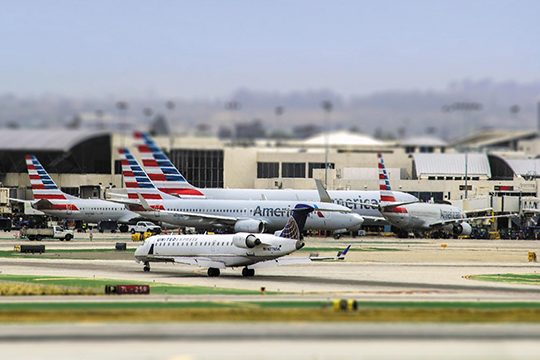Shutdown is over—now what?

LAX slowly gets up to speed as the government reboots.
After more than six weeks of stalemate, the federal government has finally reopened. The relief is palpable—from federal employees lining up at ATMs to travelers exhaling at LAX—but so are the bruises left behind. The six-week shutdown that froze paychecks, snarled travel, and rattled confidence across Los Angeles may be officially over, yet the aftershocks will take weeks or even months to fade.
This is what the shutdown did, what reopening looks like, and what Hancock Park residents can expect next.
Air travel: flights resume, but disruptions remain
The first and most visible impact of the shutdown was at the airport. By the end of last week, more than a thousand flights at Los Angeles International and surrounding airports had been delayed or canceled due to staffing shortages and FAA-ordered capacity cuts.
Now that the FAA is fully funded again, air traffic controllers and safety inspectors are returning to work—but it will take time to rebuild normal schedules.
Airlines are warning passengers to expect continued delays and limited rebooking options for another week or two. Crews and aircraft are out of position, maintenance checks are backed up, and the ripple effects are reaching far beyond the terminals. Hotel and hospitality workers who saw hours reduced during the shutdown will slowly see shifts restored as travel rebounds.
Paychecks and jobs:
confidence shaken
Roughly 57,000 federal employees in the Los Angeles metro area are finally set to receive the paychecks they’ve missed since early October. That means an immediate influx of cash into local coffee shops, grocery stores, and service businesses that saw sales slip as workers tightened budgets.
Yet the return of income does not erase the stress many endured. Federal contractors—who make up a significant share of the workforce in aerospace, IT, and security—will likely not receive back pay for lost hours. For them, the shutdown represents permanent income loss.
Local businesses depending on contractor spending, from neighborhood restaurants to dry cleaners, may feel the pinch well into the holidays.
During the shutdown, President Trump cast doubt on automatic back pay for some federal workers, saying, “There are some people that really don’t deserve to be taken care of, and we’ll take care of them in a different way.” While Congress ultimately required back pay for direct employees, those remarks left many uncertain—and the episode may make workers more cautious about spending and saving even now that paychecks are returning.
Food assistance:
benefits restarting
CalFresh benefits, part of the federal SNAP program, are resuming after a tense month in which recipients faced conflicting messages and delayed payments. November benefits were ultimately funded by court order, but the gap in communication led many households to rely on food banks and local charities.
Those emergency pantries, from Hollywood to Koreatown, report record demand over the past three weeks. Even with funding restored, agencies warn that processing backlogs could delay December distributions. Families who drained savings to get by will take months to rebuild.
For local grocers and markets, the resumption of benefits will bring welcome relief, but spending patterns may remain uneven until the public trusts that funding will stay stable.
Housing: payments
continue; damage done
Housing authorities across Los Angeles managed to continue Section 8 voucher payments through the shutdown using obligated funds and reserves. Still, landlords faced uncertainty, and some temporarily froze new rentals or upgrades.
Now that HUD operations are resuming, those delayed payments and approvals are being processed, but the backlog is heavy. Renters who experienced late notices or temporary holds may face lingering confusion about credits and balances. Officials estimate it could take another month to fully normalize housing payment cycles.
Courts and services: weeks to clear the backlog
Federal courts in Los Angeles scaled back operations in October, prioritizing criminal and emergency cases. Now, judges and clerks are rescheduling hearings, reopening civil dockets, and clearing stacks of postponed filings.
Lawyers estimate it will take six to eight weeks for civil calendars to return to normal. Cases involving business disputes, immigration petitions, and civil rights complaints will likely face extended timelines through the end of the year.
Small businesses:
catching up, cautiously
For local businesses, the reopening brings cautious optimism. Shops and service firms that saw quieter weeks during the shutdown are already seeing familiar faces return, particularly as federal employees receive lump-sum back pay.
Still, the interruption highlighted how fragile cash flow can be. Many owners had to juggle rent, payroll, and inventory without their regular customer base. Some are holding off on hiring or expansion plans until they’re confident the economy has stabilized. And for those who depend on federal contracting—especially smaller subcontractors—the financial damage may be permanent.
What reopening means in the days ahead
The return of funding sets off a flurry of activity. Agencies will spend the next week restarting systems, recalling workers, and processing delayed payments. Travelers should see flight schedules improving by mid-November, with delays tapering as the FAA resumes normal oversight.
Federal employees should receive back pay within a few business days, while benefit programs like SNAP and housing assistance will take longer—often several weeks—to untangle paperwork and catch up on missed distributions.
In the near term, local retailers and restaurants can expect a small “mini-boom” in spending as families restock and repay deferred bills. Economists note that some of that surge will offset the lost GDP from October and early November, but not all. Missed work hours, contractor losses, and canceled contracts represent real, permanent hits to the economy.
The long tail
Every government shutdown leaves scars. This one may prove especially deep because of its length—and the growing uncertainty about whether future funding fights will follow. For Hancock Park and the surrounding neighborhoods, the economic damage will fade gradually, but the emotional residue may last longer.
Households that spent six weeks living on savings or credit will be slower to take risks or make big purchases. Contractors and freelancers tied to federal work may rethink their exposure. And local businesses will be more cautious about staffing and investment through the holiday season.
A cautious return to normal
For now, planes are flying again, paychecks are arriving, and phones are ringing at government offices that have been silent for weeks. But as one Larchmont café owner put it recently, “People are back, but they’re still nervous.”
The shutdown’s end brings relief, but not closure. Hancock Park’s streets may look the same, but for many residents and workers, the experience has been a reminder that national politics can reach all the way down to the corner store. Rebuilding confidence—like reopening the government—takes time.
By Jon F. Vein
Category: News




